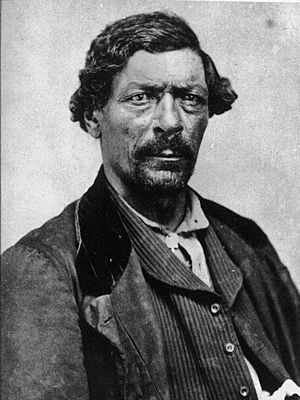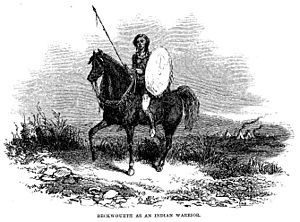James Beckwourth facts for kids
Quick facts for kids
James Beckwourth
|
|
|---|---|

James P. Beckwourth, circa 1856
|
|
| Born |
James Pierson Beckwourth
April 26, 1798 or 1800 Frederick County, Virginia, U.S.
|
| Died | October 28, 1866 or 1867 (aged 67–69) Denver, Colorado Territory, U.S.
|
| Resting place | Crow Indian Settlement, Burial Ground, Laramie, Albany County, Wyoming, U.S. |
| Other names | James Beckwith, Jim Beckwourth |
| Occupation | blacksmith, trapper, wrangler, soldier, rancher, hotel keeper, store keeper, author, scout |
| Employer | slavemaster, Rocky Mountain Fur Company, American Fur Company, Bent, St. Vrain, & Company, U.S. Government, self employed |
| Known for | Being one of the few African-American mountain men, on the American Western Frontier |
| Spouse(s) | An African-American wife and several Native American wives |
| Children | 4 |
| Military career | |
| Allegiance | |
| Service/ |
|
| Rank | U.S. Army wagon master (1837–?), U.S. Army scout (1866) Territorial militia scout (1864) |
| Battles/wars | Second Seminole War (1835–1842)
|
James Pierson Beckwourth (born Beckwith, April 26, 1798 or 1800 – October 29, 1866 or 1867), was an American mountain man, fur trader, and explorer. Beckwourth was known as "Bloody Arm" because of his skill as a fighter. He was mixed-race and born into slavery in Virginia. He was freed by his white father (and master) and apprenticed to a blacksmith so that he could learn a trade.
As a young man, Beckwourth moved to the American West, first making connections with fur traders in St. Louis. As a fur trapper, he lived with the Crow Nation for years. He is credited with the discovery of Beckwourth Pass through the Sierra Nevada, between present-day Reno, Nevada, and Portola, California, during the California Gold Rush years. He improved the Beckwourth Trail, which thousands of settlers followed to central California.
Beckwourth narrated his life story to Thomas D. Bonner, an itinerant justice of the peace. The book was published in New York City and London in 1856 as The Life and Adventures of James P. Beckwourth: Mountaineer, Scout and Pioneer, and Chief of the Crow Nation of Indians. A translation was published in France in 1860. Early historians of the Old West originally considered the book little more than campfire lore. It has since been reassessed as a valuable source of social history, especially for life among the Crow, although not all its details are reliable or accurate. The civil rights movement of the 1960s celebrated Beckwourth as an early African-American pioneer. He has since been featured as a role model in children's literature and textbooks.
Contents
Early life
James was born in 1798 into slavery in Frederick County, Virginia. Of mixed race, he had an enslaved mother who was African American. His white father was their master, Sir Jennings Beckwith, a descendant of Irish and English nobility. Little was known about Beckwourth's mother, but James was said to be third of her thirteen children.
Jennings Beckwith moved to Missouri around 1809, when James was young, taking his mother and all their children with him. Although Beckwith acknowledged and raised his mixed-race children as his own, he legally held them as master. His father arranged to apprentice him to a blacksmith so that he could learn a good trade. At age 19, he was fired by the artisan after getting into an argument with him. His father freed Beckworth by manumission, by deed of emancipation in court in 1824, 1825, and 1826.
Career
Fur trade and Crow Nation
In 1824 as a young man, Beckwourth joined General William Ashley's Rocky Mountain Fur Company. He worked as a wrangler during Ashley's expedition to explore the Rocky Mountains. In the following years, Beckwourth became known as a prominent trapper and mountain man. In July 1825, rendezvous, trapper and colleague Caleb Greenwood told the campfire story of Beckwourth's being the child of a Crow chief. He claimed Beckwourth had been stolen as a baby by raiding Cheyenne and sold to whites. This lore was widely believed, as Beckwourth had adopted Native American dress and was taken by some people as an Indian.
Later that year, Beckwourth claimed to have been captured by Crow while trapping in the border county between the territories of Crow, Cheyenne, and Blackfoot. According to his account, he was mistaken for the lost son of a Crow chief, so they admitted him to the nation. Independent accounts suggest his stay with the Crow was planned by the Rocky Mountain Fur Company to advance its trade with the tribe. Beckwourth married the daughter of a chief. (Marriages between Native Americans and fur trappers and traders were common for the valuable alliances they provided both parties.)
For the next eight to nine years, Beckwourth lived with a Crow band. He rose in their society from warrior to chief (a respected man) and leader of the "Dog Clan". According to his book, he eventually ascended to the highest-ranking war chieftaincy of the Crow Nation. He still trapped but did not sell his or Crow furs to his former partners of the Rocky Mountain Fur Company. Instead, he sold to John Jacob Astor's competing American Fur Company. Beckwourth participated in raids by the Crow on neighboring nations and the occasional white party. Sometimes such raids escalated to warfare, most often against bands of their traditional Blackfoot enemy.
In 1837, when the American Fur Company did not renew his contract, Beckwourth returned to St. Louis. He volunteered with the United States Army to fight in the Second Seminole War in Florida. In his book, he claims to have been a soldier and courier. According to historical records, he was a civilian wagon master in the baggage division.
From 1838 to 1840, Beckwourth was an Indian trader to the Cheyenne, on the Arkansas River, working out of Fort Vasquez, Colorado, near Platteville. In 1840, he moved to Bent, St. Vrain & Company. Later that same year, Beckwourth became an independent trader. Together with other partners, he built a trading post in Colorado. It was the center of development of the community of Pueblo, Colorado.
In 1844, Beckwourth traded on the Old Spanish Trail between the Arkansas River and California, then controlled by Mexico. When the Mexican–American War began in 1846, Beckwourth returned to the United States. He brought along nearly 1,800 stolen Mexican horses as spoils of war. In the war, he served as a courier with the U.S. Army and helped suppress the Taos Revolt. His former employer, Charles Bent, then interim governor of New Mexico, was slain in that revolt.
Business
By 1848 and the start of the Gold Rush, Beckwourth went to California. He first opened a store at Sonoma. He soon sold and went to Sacramento, then a boomtown close to the mines, to live as a professional card player.
In 1850, Beckwourth was credited with discovering what came to be called Beckwourth Pass, a low-elevation pass through the Sierra Nevada mountain chain. In 1851, he improved what became the Beckwourth Trail, originally a Native American path through the mountains. It began near Pyramid Lake and the Truckee Meadows east of the mountains, climbed to the pass named for him, and went along a ridge, between two forks of Feather River, before passing down through the gold fields of northern California, and on to Marysville. The trail spared the settlers and gold seekers about 150 miles (240 km) and several steep grades and dangerous passes, such as Donner Pass.
By his account, the business communities of the gold towns in California were supposed to fund the making of the trail. However, when Beckwourth tried to collect his payment in 1851 after leading a party through, Marysville had suffered from two huge fires and town leaders were unable to pay. (In 1996, in recognition of his contribution to the city's development and of the outstanding debt to him, the City of Marysville officially renamed the town's largest park as Beckwourth Riverfront Park.)
Beckwourth began ranching in the Sierra. His ranch, trading post and hotel, in today's Sierra Valley, were the starting of the settlement of Beckwourth, California. In the winter of 1854/55, the itinerant judge Thomas D. Bonner stayed in the hotel, and on winter nights Beckwourth told him his life story. Bonner wrote it down, edited the material the following year, and offered the book to Harper & Brothers in New York. The Life and Adventures of James P. Beckwourth was published in 1856. According to the contract, Beckwourth was entitled to one half of the proceeds, but he never received any income from Bonner. The book provides historical information on how U.S. government officials used alcohol; how occupations affect those who work in the field; the historical relationship among diseases, wildlife, and the environment; as well as reports dealing with massacres and war.
Government and Army service
In 1859, Beckwourth returned to Missouri briefly but settled later that year in Denver, Colorado Territory. He was a storekeeper working again for Louis Vasquez and was appointed as a local Indian agent. In 1864, Beckwourth was hired as a scout by Colonel John M. Chivington, commander of the 3rd Colorado Cavalry Regiment. He was to serve in a campaign against the Cheyenne and Apache, leading a frontier paramilitary volunteer militia formed to annihilate indigenous inhabitants in the territory for the American settlers. The Colorado Territory campaign resulted in the Sand Creek massacre, in which the hostile militia killed an estimated 70-163 friendly Cheyenne men, women and children, who had camped in an area suggested by the previous commander of Fort Lyon as a safe place and were flying an American flag to show their peaceful intentions. Outraged by his association with the massacre, the Cheyenne banned Beckwourth from trading with them.
Well into his 60s by then, Beckwourth returned to trapping. In 1866, during Red Cloud's War, the U.S. Army employed him as a scout at Fort Laramie and Fort Phil Kearny..
Death
While guiding a military column to a Crow band in Montana, Beckwourth complained of severe headaches and suffered nosebleeds, most probably the result of a severe case of hypertension. He returned to the Crow village, where he died in 1867 of natural causes. William Byers, a personal friend and the founder of the Rocky Mountain News, claimed the Crow had poisoned Beckwourth. He said the tribe felt they could no longer trust him because of his involvement in the Sand Creek massacre. Byers had no supporting evidence, and his claim was speculation. Beckwourth's body was placed on an elevated platform in the traditional funerary custom of the Crow Tribe at the Crow Indian Settlement Burial Ground, Laramie, Albany County, Wyoming.
Legacy
- Beckwourth Pass, named in honor of Beckwourth, is located in the Sierra Nevada Mountains in Plumas County, California. This pass and route was used by the Western Pacific Railroad to cross the Sierra along their Feather River route. The pass is located east of Portola, California. State Route 70 crosses the Sierra at this pass at an elevation of 1,591 m (5,221 ft); it is one of the lowest crossings of the Sierra Nevada in California.
- In 1994, the U.S. Postal Service issued a 29-cent commemorative postage stamp honoring Beckwourth as part of the set Legends of the West.
- In 1996, the city of Marysville, California renamed its largest park as Beckwourth Riverfront Park to commemorate his contributions to development of the city. For a few years, the "Beckwourth Frontier Days" were celebrated annually in October and were the only living history festival in northern California.
- What is now West 5th Ave. in Denver, Colorado, was named Beckwourth Street (sometimes Beckwith) after James Beckwourth.
- In 2011 a memorial commemorating Beckwourth's role in the founding of Pueblo, Colorado, was erected in that city.
See also
 In Spanish: James Beckwourth para niños
In Spanish: James Beckwourth para niños


